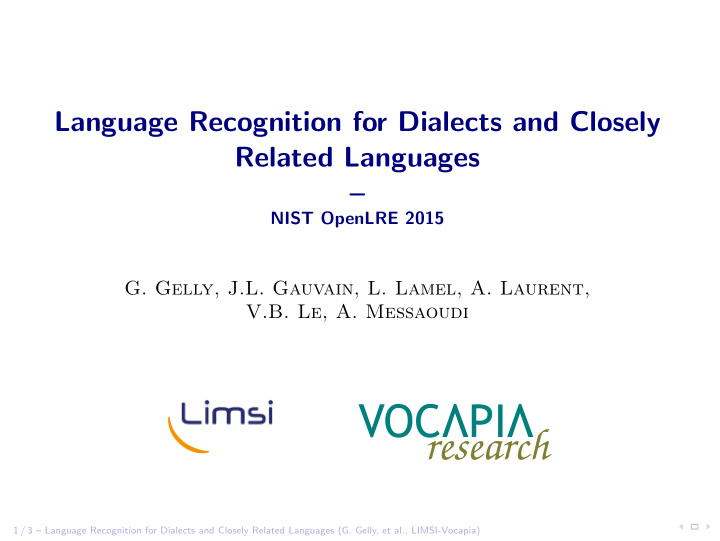



Language Recognition for Dialects and Closely Related Languages – NIST OpenLRE 2015 G. Gelly, J.L. Gauvain, L. Lamel, A. Laurent, V.B. Le, A. Messaoudi 1 / 3 – Language Recognition for Dialects and Closely Related Languages (G. Gelly, et al., LIMSI-Vocapia)
Pitch Main objectives Being able to identify the dialect when given excerpts of spoken conversations Benchmark different LID approaches in preparation for NIST LRE15 Techniques studied Phonotactic I-vectors LSTM-RNN Lexical 2 / 3 – Language Recognition for Dialects and Closely Related Languages (G. Gelly, et al., LIMSI-Vocapia)
Pitch Main results LSTM-RNN can lead to a lower LER than I-vectors Phonotactic is the most robust method Phonotactic and LSTM-RNN fusion can lead to an important LER reduction 50 por-brz PHO spa-lac 45 RNN spa-eur IVC spa-car 40 LEX qsl-rus RNN+PHO qsl-pol 35 RNN+PHO+IVC fre-hat system output fre-waf RNN+PHO+IVC+LEX eng-sas average LER 30 eng-usg eng-gbr 25 zho-wuu zho-cdo zho-cmn 20 zho-yue ara-arb 15 ara-ary ara-apc 10 ara-acm ara-arz 5 ara-arz ara-acm ara-apc ara-ary ara-arb zho-yue zho-cmn zho-cdo zho-wuu eng-gbr eng-usg eng-sas fre-waf fre-hat qsl-pol qsl-rus spa-car spa-eur spa-lac por-brz 0 [0;5] ]5;10] ]10;20] ]20;30] > 30 all speech duration in seconds target dialect 3 / 3 – Language Recognition for Dialects and Closely Related Languages (G. Gelly, et al., LIMSI-Vocapia)
Recommend
More recommend